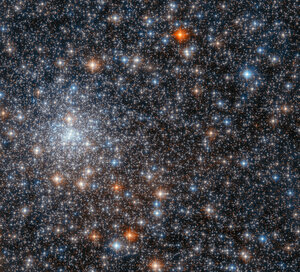

A glittering cluster shines again
As part of ESA/Hubble’s 35th anniversary celebrations, a new image series has been shared throughout April to revisit stunning Hubble targets that were previously released. New images of NGC 346, the Sombrero Galaxy, and the Eagle Nebula have already been published. Now, ESA/Hubble is revisiting the star cluster Messier 72 (M72) with new data and image processing techniques.
M72 is a particularly special target because it was the first image ever published in the ESA/Hubble Picture of the Week series, on 22 April 2010. For fifteen years, the ESA/Hubble team has been publishing a new Hubble image every Monday for everyone to enjoy. This has resulted in nearly 800 images being added to the vast Hubble image archive over the years.
M72 is a collection of stars, formally known as a globular cluster, located in the constellation Aquarius roughly 50 000 light years from Earth. The intense gravitational attraction between the closely packed stars gives globular clusters their regular, spherical shape. Roughly 150 clusters such as this have been discovered in the Milky Way galaxy.
The striking variety in the colour of the stars in this image of M72, particularly compared to the original image, results from adding ultraviolet observations to the previous visible-light data. The colours indicate groups of different types of stars. Blue stars are those in the cluster that were originally more massive, and have now reached hotter temperatures after burning through much of their hydrogen fuel; the bright red objects are lower-mass stars that have now become red giants. Studying these different groups help astronomers to understand how globular clusters, and the galaxies they were born in, initially formed.
Pierre Méchain, a French astronomer and colleague of Charles Messier, discovered M72 in 1780. It was the first of five star clusters that Méchain would discover while assisting Messier. It was recorded as the 72nd entry in Messier’s famous collection of astronomical objects, and the object is also one of the most remote clusters in the catalogue.
The ESA/Hubble science outreach team invites members of the public as well as all scientists who have had (or will have) approved Hubble observing time to contact us if you feel you have aesthetically appealing yet visually informative image data that could be featured in this series!
[Image Description: A cluster of many thousands of bright stars. In the centre most of the stars are blue, while this centre is surrounded by a thick shell of yellower stars, seen in differing sizes according to their position in the spherical star cluster. They spread out beyond the edges of the image, becoming smaller and more sparse only at the corners. A distant spiral galaxy is also visible in the very corner.]





